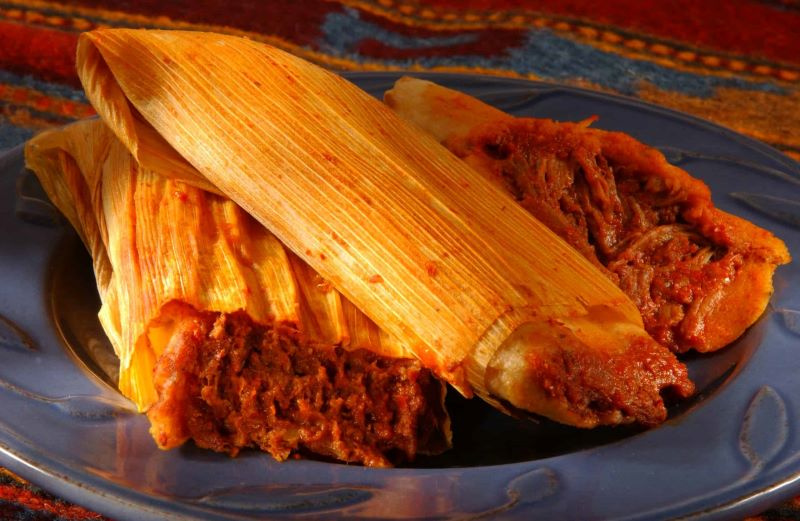By TR Robertson
There are multitudes of traditions surrounding the Christmas season. Many of these traditions have grown out of customs from a variety of cultures, passed down through generations of families. Many of these have assimilated throughout societies regardless of where they came from, many are ancient, many are new, many are unique to just your family. If you look historically at some of the traditions that once were part of different societies and cultures, you might have a difficult time imagining why they began, why people kept them around for a while and what would lead to the tradition being discontinued. This article will touch on some of the more common traditions people still practice during the Christmas holiday season and some of the stranger Christmas traditions that no longer exist.
• Tamales do not sound like a Christmas dish, but Mexican families have adopted the corn husks filled with meat or vegetable delights as a Christmas traditional food along with a time for tamaladas – tamale-making parties.

• Tamales date back as far as 8,000 B.C. to Mesoamerican civilizations.
• The Christmas tree is a German import brought to Britain during the 1840’s by Prince Albert.
• The giving of Christmas cards is a Victorian invention.
• Goose was the traditional Christmas food staple in Britain.
• Pantomime theatre began in Renaissance Italy with traveling street artists and was imported to Britain in the 1700’s by John Rich and David Garrick where Christmas pantomime theatre was performed.
• In Medieval England, boy bishops celebrated a Feast of Fools by going to people’s doors telling ghost stories on Christmas Eve.
• It was once believe burning the biggest log in the hearth would turn the dark night of winter as bright as day. Taking a fragment of this yule log and placing it under the bed would protect the house from fire and lightning for the year.
• It was believed throwing a piece of the yule log into the fire would stop a storm outside.
• In the 1600’s, young men and women would throw food at a wall during Christmas dinner to see if the food that stuck would spell the name of their future spouse.
• In Wales, their once was a tradition of holly-beating or holming, where young men and boys would hit the bare arms of young women with holly branches until they drew blood.
• Also, in Wales, there was a tradition to try and beat the last person out of bed on Boxing Day.
• The tradition of Boxing Day, on December 26, involved delivery boys, tradesmen, tenants, and servants collecting their Christmas boxes of money, food, and other goodies.
• In Medieval times, every Christmas, the York Minster held a Mistletoe Service at which all evil doers were invited to attend. Because of pagan association, mistletoe was banned from the church. The Minster ignored this and used a mistletoe branch to give “all sorts of wicked and inferior people pardon and freedom.” The service is no longer held but a sprig of mistletoe is still placed on the alter.
• In England, to go a wassailing once meant to go door to door singing Christmas carols to mark midwinter.
• When the Puritans held power in England, Christmas singalongs were banned as frivolous.
• The melody of “O Little Town of Bethlehem was written by Ralph Vaughan Williams, in the 1800’s, from a tune he heard a farm laborer sing.
• The tradition of building snowmen began in the Middle Ages and Renaissance period when they were built as winter effigies depicting folklore figures, religious and political themes and at times sexualized sculptures.
• The robin is considered a charming symbol of winter, but in Gloucestershire, as recent as the 1950’s, it was thought to receive a robin or any wild bird in your house in any form would signify an impending death in the family.
• The bringing of holly into your home at any time other than Christmas was also a sign of impending death and the holly must be burned once the holiday season was over
• In the 1800’s, the taking of fire outside of your home was considered bad luck.
• In European folklore, chimneys were once associated as entry points for both good and evil spirits. In Greece and Serbia, Kallikantzaroi or Christmas goblins, lived underground and would appear during the 12 days before Christmas to wreak havoc, entering the home down chimneys.
• To keep the evil spirits out yule logs were lit, also putting a pair of foul-smelling shoes on the flames would help.
• In 16th century Holland, children would place shoes on the hearth on the eve of the feast of Saint Nicholas, hoping they would be filled with gifts and sweets. One story has St. Nicholas placing gold coins in the shoes.
• In Italian folklore, it was believed an old woman named Befana, the Christmas witch, would place gifts in children’s shoes on the eve of epiphany, January 6.
• Oliver Cromwell and the Puritans once sought to abolish Christmas viewing it as a “popish superstition.”
• One Puritan ordinance, in 1647, threatened to punish anyone who celebrated the holiday.
• In Canterbury, in 1647, the ordinance led to a riot.
• In World War I, a war-and-peace pudding was made featuring carrots instead of mincemeat.
• In WW II, a recipe booklet was produced with instructions for carrot soup, carrot savory, carrot croquettes and the war-and-peace pubbing.
• On Christmas Day in 1927, the Royal Chef Andre Cedard, chef for George V, made a pudding called “a symbol of unity of empire”. It was made with currants from Australia, raisins from South Africa, minced apple from Canada, demerara sugar from the West Indies, ground cloves from Zanzibar and brandy from Cyprus.
• In England, children once wrote letters to Father Christmas, and put the letters in the fireplace to rise up the chimney to reach him.
• Seahorses were once caught and dried to be used as Christmas decorations on trees.
• In China, ground seahorse was once thought to be used as a remedy for a man’s low libido
This is but a sample of the many customs, traditions and folklore surrounding Christmas from a variety of countries around the world. Regardless of what you believe, have a safe, happy and joyous holiday season.



















